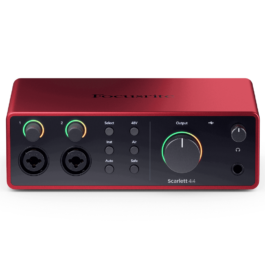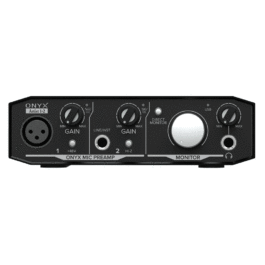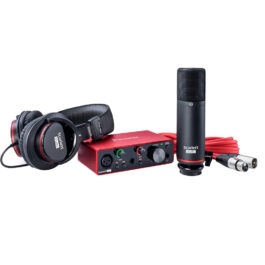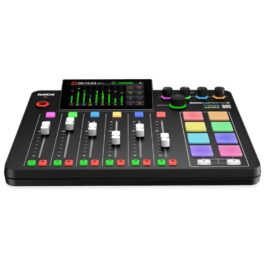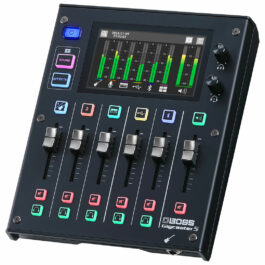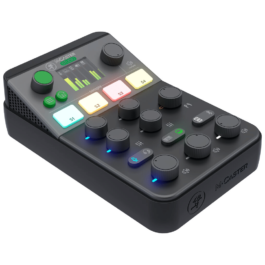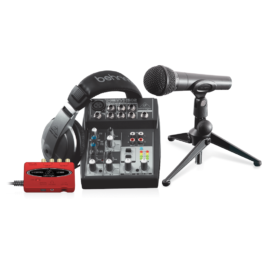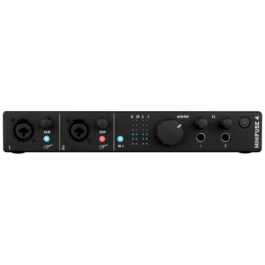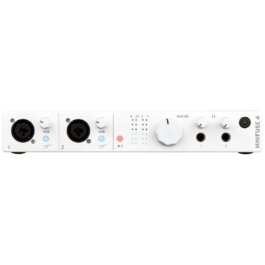
-
Birthday Sale Deal!
- Studio & Recording, Audio Interfaces, Content Creation, Audio, Audio Interfaces
Focusrite Scarlett 4i4 4th Gen USB Audio Interface
- R6,000FREE DELIVERY
- 4-in/4-out USB-C Audio Interface with 2 Mic Preamps, Auto Gain, Clip Safe, Dynamic Gain Halos, Easy Start, and Hitmaker Expansion Bundle
- Select options
-
Birthday Sale Deal!
- Audio Interfaces, Audio Interfaces, Content Creation, Studio & Recording
Rode AI-1 Audio Interface
- R3,115FREE DELIVERY
- The RØDE AI-1 Audio Interface is packed with incredible technology to ensure recording on your computer is easy, versatile and sounds superb. The AI-1’s single input is a…
- Select options
-
Birthday Sale Deal!
- Audio Interfaces, Audio Interfaces, Content Creation, Studio & Recording
Behringer U-Phoria UM2 Audio Interface
- R1,548FREE DELIVERY
- If you're looking for a simple, affordable, and effective way to record music on your Mac or Windows PC, then check out the Behringer U-Phoria UM2.The U-Phoria UM2…
- Select options
-
Birthday Sale Deal!
- Studio & Recording, Audio Interfaces, Content Creation, Audio Interfaces, Clearance Sale
Mackie Onyx Artist USB Audio Interface
- R1,960FREE DELIVERY
- Combining high-resolution 24-bit/192kHz converters with premium Mackie analog circuitry and Built-Like-A-Tank™ hardware design, the bus-powered Onyx Series USB Audio Interfaces give you the power to capture your best…
- Select options
-
Birthday Sale Deal!
- Studio & Recording, Audio Interfaces, Content Creation, Audio Interfaces, Clearance Sale
Mackie Onyx Producer Audio Interface
- R2,540FREE DELIVERY
- Perfect for Singer/songwriters and content creators will love the Mackie Onyx Producer 2-2. High-resolution 24-bit/192kHz converters combine with premium analog circuitry to deliver top-notch sound. A pair of…
- Select options
-
- Studio & Recording, Audio Interfaces
Focusrite Scarlett 2i2 4th Gen USB Audio Interface
- R4,175FREE DELIVERY
- 2-in/2-out USB-C Audio Interface with 2 Mic Preamps, Auto Gain, Clip Safe, Dynamic Gain Halos, Easy Start, and Hitmaker Expansion Bundle
- Select options
-
- Audio Interfaces, Studio & Recording
Focusrite Scarlett Solo 4th Gen USB Audio Interface
- R2,960FREE DELIVERY
- 2-in/2-out USB-C Audio Interface with 1 Mic Preamp, Auto Gain, Clip Safe, Dynamic Gain Halos, Easy Start, and Hitmaker Expansion Bundle
- Select options
-
Birthday Sale Deal!
- Audio Interfaces, Clearance Sale, Studio & Recording, Studio Bundle
Focusrite Scarlett Solo Studio Pack – 3rd Gen
- R4,445FREE DELIVERY
- EVERYTHING YOU NEED TO RECORD GUITAR AND VOCALS AT THE SAME TIME You’ve found the simplest way to create incredible recordings of your music. Featuring the smallest USB…
- Select options
-
Birthday Sale Deal!
- Studio & Recording, Audio Interfaces, Content Creation, Audio, Podcasting Mixers
RØDE Rodecaster Pro II Integrated Audio Production Studio
- R19,209FREE DELIVERY
- The RØDECaster Pro II is the ultimate audio production solution for content creators, including streamers, podcasters and musicians. Combining revolutionary features with superior sound quality, endless customisability and…
- Select options
-
Birthday Sale Deal!
- Studio & Recording, Audio Interfaces, Studio Mixing Desks, Audio, Podcasting Mixers
BOSS Gigcaster 8 Audio Streaming Mixer
- R18,995FREE DELIVERY
- Gigcaster 8 is a powerful all-in-one audio command center purpose-built for musicians who livestream and create audio and video content. It delivers all the tools you need for…
- Select options
-
Birthday Sale Deal!
- Studio & Recording, Audio Interfaces, Studio Mixing Desks, Audio, Podcasting Mixers
BOSS Gigcaster 5 Audio Streaming Mixer
- R12,995FREE DELIVERY
- Gigcaster 5 is a powerful all-in-one audio command center purpose-built for musicians who livestream and create audio and video content. It provides a host of advanced features in…
- Select options
-
Birthday Sale Deal!
- Studio & Recording, Audio Interfaces, Content Creation, Audio, Podcasting Mixers
RØDE Rodecaster Duo – Integrated Audio Production Studio
- R14,789FREE DELIVERY
- The RØDECaster Duo is the ultimate compact audio solution for podcasters and content creators. Combining revolutionary features with superior sound quality, endless customisability and unmatched ease of use,…
- Select options
-
Birthday Sale Deal!
- Audio Interfaces, Studio & Recording
Audient EVO 16 24in | 24out Audio Interface
- R13,260FREE DELIVERY
- 24-in/24-out USB Audio Interface with Multichannel Smartgain, 8 Preamps, 2 JFET Instrument Inputs, 2 Headphone Outputs, and High-resolution TFT-LCD Screen - Mac/PC
- Select options
-
Birthday Sale Deal!
- Studio & Recording, Audio Interfaces, Content Creation, Audio, Podcasting Mixers
Mackie MCaster Studio Portable Streaming/Podcast Mixer – Black
- R4,674FREE DELIVERY
- BREATHE LIFE INTO YOUR LIVE STREAM Podcasters and content creators looking for an easy-to-use audio solution for solo livestreaming on mobile devices, laptops in the studio, and on…
- Select options
-
Birthday Sale Deal!
- Studio & Recording, Audio Interfaces, Content Creation, Audio, Podcasting Mixers
Behringer Podcastudio USB Podcast Bundle
- R3,395FREE DELIVERY
- Complete PODCASTUDIO Bundle with USB/Audio Interface
- Select options
-
Birthday Sale Deal!
- Audio Interfaces, Audio Interfaces, Content Creation, Studio & Recording
Arturia MiniFuse 4 USB-C Audio Interface – Black
- R5,435FREE DELIVERY
- Turn your creative ideas into content for the world to hear with the black Arturia MiniFuse 4, a portable 4x4 USB Type-C audio/MIDI interface that combines great sound…
- Select options
-
Birthday Sale Deal!
- Studio & Recording, Audio Interfaces, Content Creation, Audio Interfaces
Arturia MiniFuse 4 USB-C Audio Interface – White
- R5,435FREE DELIVERY
- Turn your creative ideas into content for the world to hear with the white Arturia MiniFuse 4, a portable 4x4 USB Type-C audio/MIDI interface that combines great sound with…
- Select options
-
Birthday Sale Deal!
- Audio Interfaces, Audio Interfaces, Content Creation, Studio & Recording
Roland Studio-Capture UA-1610 USB Audio Interface
- R18,125FREE DELIVERY
- USB 2.0 Recording Interface with 12 Mic Preamps and DSP for Cue Mixing
- Select options
Audio interfaces are perhaps one of the most important pieces of gear when it comes to recording music digitally. In fact, proper audio recording is not possible without one. Therefore when starting out, big or small, an audio interface is definitely one of the first places to start. Not only will you find audio interfaces in every Studio of every home producer. But, you will find audio interfaces in some of the world’s biggest professional recording studios
What is an audio interface? An interface allows you to convert raw audio from a microphone, guitar or a MIDI device. And it then processes that audio into a digital file.
There are many different audio interfaces on the market to suit the specific needs of each aspiring producer or musician. However, determining which audio interface is for you will come down to a few key elements. Besides for the obvious price Factor, one will need to decide what he/she would like to achieve in the recording process. With that in mind, choosing an audio interface becomes a much easier task. For example, an engineer for a large Studio will prefer a bigger audio interface in comparison to a home producer who most likely would only be recording one instrument at a time.
Another important factor to consider when buying an audio interface is deciding which ports on your device you will be using. For example, most PC’s would require a USB interface. Whereas some Mac users would prefer a FireWire interface or a Thunderbolt unit instead. whilst USB is the most common type of audio interface there are other options out there which are much faster.


